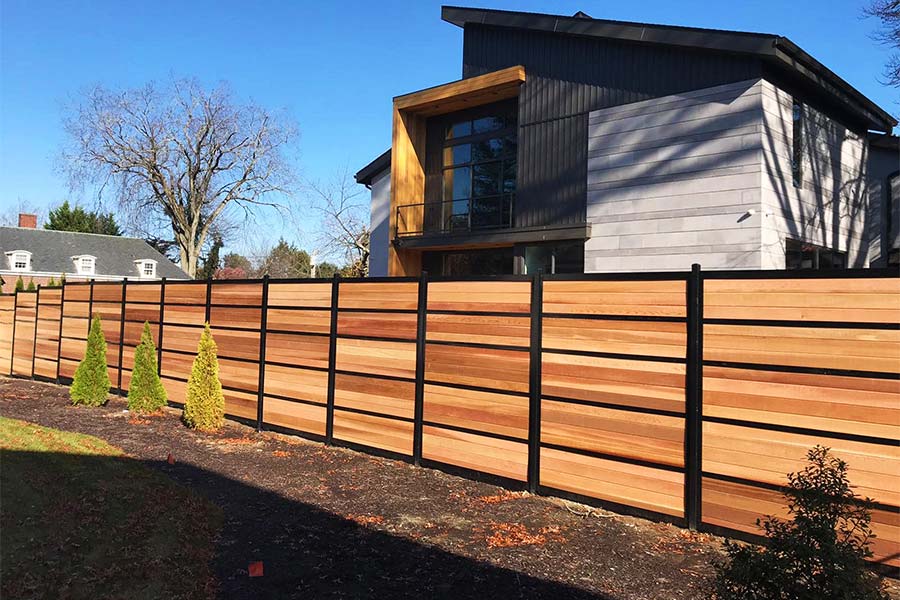All Categories
Featured

Whether it's solid winds, rainfall, snow, or extreme heat, weather problems can slowly weaken your fence, leading to expensive repairs or replacement. There are numerous steps you can take to safeguard your fence from weather-related damages and expand its life-span.
- Choose the Right Product. The type of material your fence is made from plays a significant duty in how well it will stand up to climate condition. Some materials are naturally much more immune to damage than others. For instance:
Wood Fencings: While gorgeous and timeless, wood can be susceptible to dampness, rot, and pests. Pressure-treated wood or cedar can supply far better resistance to these problems. Vinyl Fencings: Vinyl is very resistant to moisture, rot, and insects. It also stands up well to extreme sunlight and heavy rain. Steel Fences: Wrought iron or aluminum fencings are resilient and can withstand a selection of climate condition. They can, however, experience rust gradually, specifically otherwise correctly coated. Compound Fences: Made from a mixture of timber fibers and plastic, composite fencings are extra resistant to weather-related damages compared to typical wood fences. Selecting the right product for your region's environment is the very first action in safeguarding your fence from weather condition damage.
- Seal or Discoloration Wooden Fences. Wooden fencings are especially prone to damage from moisture, UV rays, and temperature changes. Among one of the most reliable ways to shield your timber fence is by applying a protective sealant or stain. These products help:
Stop Water Damage: Sealants create a water-resistant barrier, stopping moisture from permeating into the timber and creating mold, mold, or rot. Protect Versus UV Damages: A good discolor or sealer will certainly likewise obstruct dangerous UV rays from the sunlight, which can create wood to dry, fracture, and blemish with time. Maintain the Fencing's Appearance: Normal staining aids preserve the all-natural elegance of the wood and extends its lifespan. It's recommended to reapply the tarnish or sealant every 1-- 2 years to keep your fence in good problem.
- Mount a Barrier for Wind Security. Solid winds can cause considerable damage to your fencing, specifically if it is weak or tall. Wind can flex or break wooden panels, loosen fence messages, or perhaps create the whole fencing to collapse. Installing a windbreak-- such as planting hedges, bushes, or installing a mesh obstacle-- can aid secure your fence from high winds.
In addition, you can enhance the messages with concrete or steel braces to give added security and avoid leaning or changing.
- Trim Overhanging Branches. Dropping branches can break panels or harm the fencing messages, leading to costly repairs. Keeping the branches reduced back minimizes the threat of branches breaking off and causing damages to the fence.
- Normal Evaluations and Maintenance. Doing regular maintenance and examinations is vital to capturing prospective problems prior to they escalate. After a heavy storm, check your fencing for any type of indicators of damage, such as loose panels, leaning messages, or busted areas. Looking after tiny concerns prior to they become larger ones can assist extend the life of your fencing.
Furthermore, cleansing your fencing regularly to eliminate dust, debris, or mold can aid maintain its appearance and honesty. For wooden fences, gently stress clean the surface to eliminate built-up grime, and for vinyl fencings, make use of a mild cleaning agent to clean any discolorations.

- Make Certain Appropriate Drain. Water damage is one of the most usual weather-related problems that affect fences. Poor drain can lead to standing water around your fence articles, which can cause the posts to rot or deteriorate over time.
- Use a Protective Finish to Steel Fencings. Metal fencings, such as those made of iron or steel, are extremely long lasting however can be susceptible to rust otherwise appropriately maintained. Using a protective layer or paint that is specifically designed for metal can help prevent rust and corrosion. Be certain to examine the fencing periodically for any kind of indications of rust, and address it quickly by fining sand and repainting the affected locations.

Final thought. Your fence is a useful investment, and shielding it from weather-related damage will help make certain that it continues to serve its purpose for several years to come. By choosing the appropriate materials, routinely maintaining your fencing, and taking actions to protect it from the aspects, you can minimize weather-related damages and extend its lifespan. Whether you're managing strong winds, heavy rainfall, or the rough sunlight, these straightforward steps can go a lengthy way in preserving the condition and appearance of your fence, saving you money and time in the long run.
Latest Posts
Learn About Montclare Auto Repair’s Top Auto Repairs and Why Drivers Trust Them
Published May 26, 25
1 min read
Find Exceptional Vehicle Maintenance Solutions from Montclare Auto Repair – Keep Your Car Running Smoothly
Published May 26, 25
1 min read
Explore Budget-Friendly Auto Repairs with Montclare’s Limited-Time Service Specials
Published May 25, 25
1 min read
More
Latest Posts
Learn About Montclare Auto Repair’s Top Auto Repairs and Why Drivers Trust Them
Published May 26, 25
1 min read
Find Exceptional Vehicle Maintenance Solutions from Montclare Auto Repair – Keep Your Car Running Smoothly
Published May 26, 25
1 min read
Explore Budget-Friendly Auto Repairs with Montclare’s Limited-Time Service Specials
Published May 25, 25
1 min read